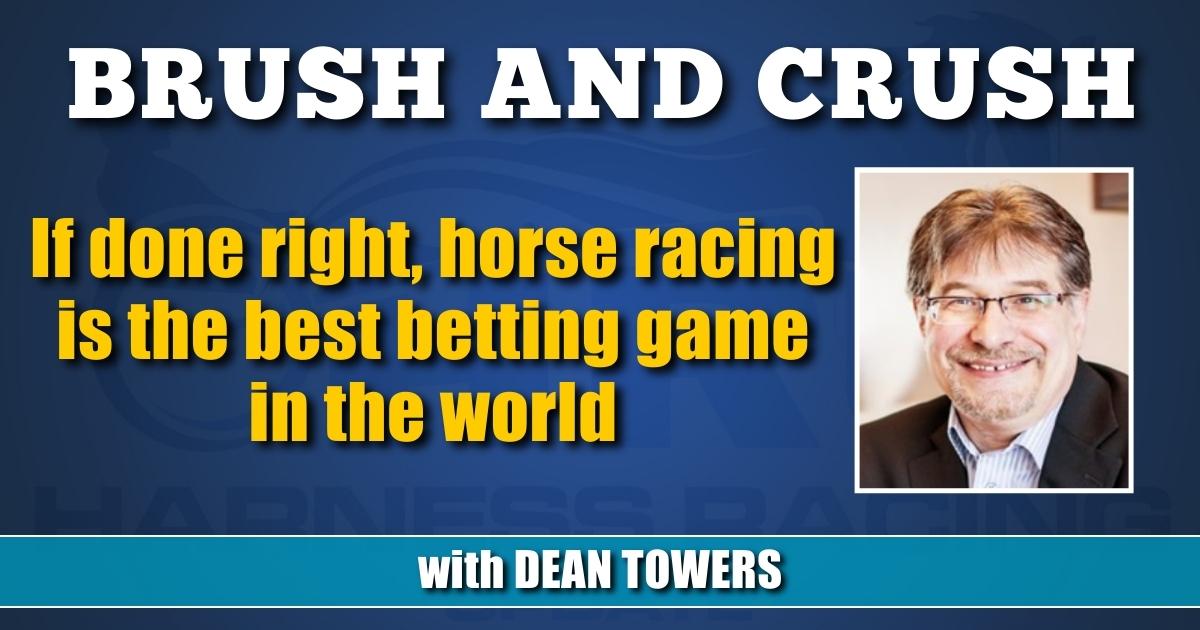If done right, horseracing is the best betting game in the world
This week’s “Bet With the Best” podcast helps illustrate how the glass is half full.
by Dean Towers
Chris Larmey is a member of the National Handicapping Hall of Fame and he started a new horse racing podcast a few weeks ago called “Bet With the Best.”
Rather than focusing on picks, the pod is concentrated solely on game play; that is, how to bet the horses correctly from a gambling perspective. I think the four guests to date have all been tremendous.
This week’s episode with a professional horseplayer — a player who still plays harness regularly — I found a particularly eye-opening adventure.
The bettor, who goes by the moniker “Inside the Pylons,” has been betting forever and he detailed the state of the current game for the player, how the game was played in the past and how things could be improved. I encourage those in power in the sport to give it a listen.
Here are a few points that I’d like to highlight:
First, he spoke about how when we invite new players to the medium, it’s not near optimal. We may teach new customers the basics of betting (and the dutiful folks who work on track or on the simulcast screens are certainly helpful), but we teach them very little about making good bets.
This is the antithesis to sports betting, daily fantasy or poker spaces. Teaching customers how to play their games smartly is pretty much all they do.
I understand the industry wants to promote the horses or trainers or drivers, but when a customer walks into the track they’re making wagers, not buying horses. The industry could do much better cultivating interest in wagering if they teach betting concepts from day one and beyond.
Second, he talked about how he wagered 20-plus years ago to today. Back in the early 2000s, field size was bigger, but not only that, the depth of field was deeper. Those of us remember The Meadowlands during that time where seven of 10 horses could win a race, versus today where three or four can.
Depth of field adds to the bettable combinations of a race and makes it easier to find profitable angles. It raises handles.
Sure, the sport may need 14 races a night to distribute purse money and keep the average cost per race down. However, if eight of those 14 races are not bettable, the player will find something else to bet on. It’s not like there isn’t any competition out there.
Third, he spoke about high takeout. We’ve talked about it before in this very column and I understand how some folks’ eyes glaze over when bringing it up, but the issue seems as paramount as ever.
Pylons talked about the newer or existing smaller player being herded into high takeout, while contrasting that with the large teams who earn 10 per cent rebates or more on their wagers. It’s a strong point.
If you bet $1 million a year and walk into any ADW they will give you lower takeout immediately and you’ll bet three, four, five or six times that amount in no time. Meanwhile, the newer or existing player who may bet $10,000 per year and could bet $300,000 or $400,000 with a break over time is not even an afterthought.
Successful betting entities don’t think like this and fortunately there is empirical data to back this up.
The Massachusetts lottery used to have usurious 70 per cent takeout rates, but over the last three decades they’ve brought them down to around 25 per cent; in some games below 20 per cent. This has resulted in a cultivation of the lottery customer to the tune of $933 in lottery spending per capita per year, by far the highest in the nation. In fact, it’s a whopping 77 per cent more than higher takeout New York state.
For contrast, we all know Australian horse racing is fairly healthy with record handles set each year and the North American racing industry often wishes it had its reach. The average Australian spends US$871 per year on horse racing. That’s lower than per capita wagering on the Massachusetts lottery.
People will tell you takeout doesn’t matter in lotteries, because some survey somewhere asked players if it did and they said it didn’t matter. That’s incorrect. High takeout is a silent killer. It matters in any game because the lower the juice, the higher the churn.
When we look at how the sport is currently run from a wagering perspective, I think we can conclude that the glass is probably not half empty, but half full.
Think about it for a moment: we have races with pool size going off from morning to deep into the night, seven days a week. We can watch and wager from our phones, iPads or computers via easy-to-use betting accounts. Each of these races is unique. They’re like a slot pull or scratch ticket for smart people.
If we construct better races, teach the people who come into the door how to wager properly and offer both they and our regular bettors a chance at better takeout rates, handle will likely increase and could increase by a multiple. There’s just so much opportunity.
Many of us think horse racing is the greatest gambling game the world has ever constructed. It just needs to be unleashed.

















